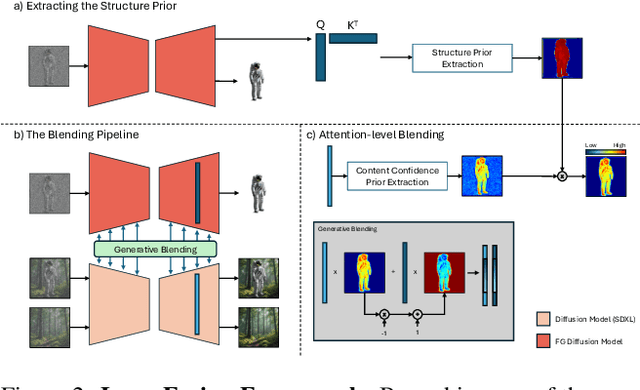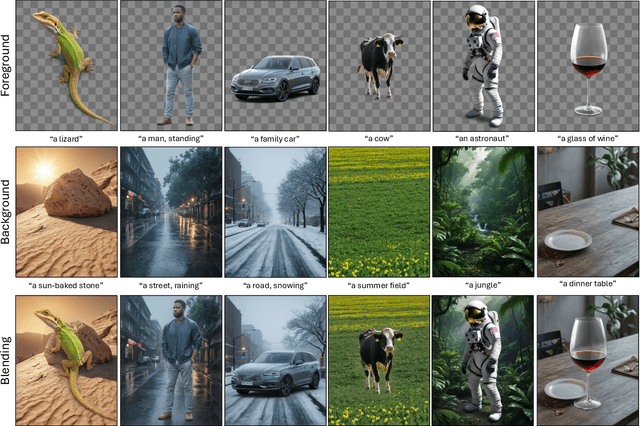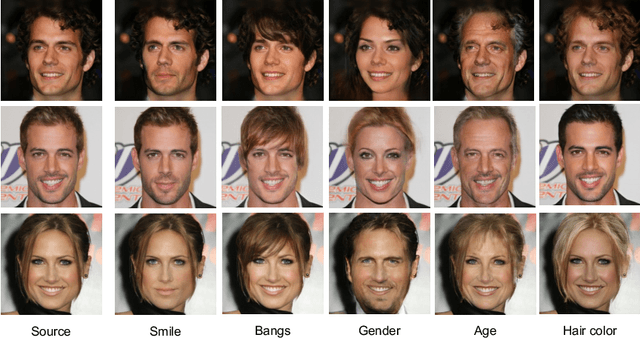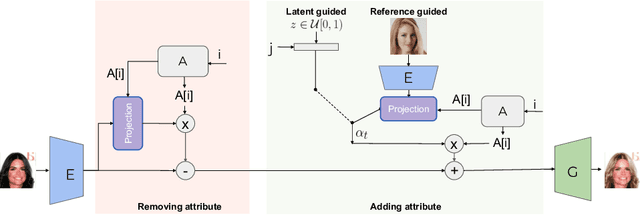Yusuf Dalva
FluxSpace: Disentangled Semantic Editing in Rectified Flow Transformers
Dec 12, 2024



Abstract:Rectified flow models have emerged as a dominant approach in image generation, showcasing impressive capabilities in high-quality image synthesis. However, despite their effectiveness in visual generation, rectified flow models often struggle with disentangled editing of images. This limitation prevents the ability to perform precise, attribute-specific modifications without affecting unrelated aspects of the image. In this paper, we introduce FluxSpace, a domain-agnostic image editing method leveraging a representation space with the ability to control the semantics of images generated by rectified flow transformers, such as Flux. By leveraging the representations learned by the transformer blocks within the rectified flow models, we propose a set of semantically interpretable representations that enable a wide range of image editing tasks, from fine-grained image editing to artistic creation. This work offers a scalable and effective image editing approach, along with its disentanglement capabilities.
Context Canvas: Enhancing Text-to-Image Diffusion Models with Knowledge Graph-Based RAG
Dec 12, 2024Abstract:We introduce a novel approach to enhance the capabilities of text-to-image models by incorporating a graph-based RAG. Our system dynamically retrieves detailed character information and relational data from the knowledge graph, enabling the generation of visually accurate and contextually rich images. This capability significantly improves upon the limitations of existing T2I models, which often struggle with the accurate depiction of complex or culturally specific subjects due to dataset constraints. Furthermore, we propose a novel self-correcting mechanism for text-to-image models to ensure consistency and fidelity in visual outputs, leveraging the rich context from the graph to guide corrections. Our qualitative and quantitative experiments demonstrate that Context Canvas significantly enhances the capabilities of popular models such as Flux, Stable Diffusion, and DALL-E, and improves the functionality of ControlNet for fine-grained image editing tasks. To our knowledge, Context Canvas represents the first application of graph-based RAG in enhancing T2I models, representing a significant advancement for producing high-fidelity, context-aware multi-faceted images.
LayerFusion: Harmonized Multi-Layer Text-to-Image Generation with Generative Priors
Dec 05, 2024



Abstract:Large-scale diffusion models have achieved remarkable success in generating high-quality images from textual descriptions, gaining popularity across various applications. However, the generation of layered content, such as transparent images with foreground and background layers, remains an under-explored area. Layered content generation is crucial for creative workflows in fields like graphic design, animation, and digital art, where layer-based approaches are fundamental for flexible editing and composition. In this paper, we propose a novel image generation pipeline based on Latent Diffusion Models (LDMs) that generates images with two layers: a foreground layer (RGBA) with transparency information and a background layer (RGB). Unlike existing methods that generate these layers sequentially, our approach introduces a harmonized generation mechanism that enables dynamic interactions between the layers for more coherent outputs. We demonstrate the effectiveness of our method through extensive qualitative and quantitative experiments, showing significant improvements in visual coherence, image quality, and layer consistency compared to baseline methods.
The Curious Case of End Token: A Zero-Shot Disentangled Image Editing using CLIP
Jun 01, 2024Abstract:Diffusion models have become prominent in creating high-quality images. However, unlike GAN models celebrated for their ability to edit images in a disentangled manner, diffusion-based text-to-image models struggle to achieve the same level of precise attribute manipulation without compromising image coherence. In this paper, CLIP which is often used in popular text-to-image diffusion models such as Stable Diffusion is capable of performing disentangled editing in a zero-shot manner. Through both qualitative and quantitative comparisons with state-of-the-art editing methods, we show that our approach yields competitive results. This insight may open opportunities for applying this method to various tasks, including image and video editing, providing a lightweight and efficient approach for disentangled editing.
GANTASTIC: GAN-based Transfer of Interpretable Directions for Disentangled Image Editing in Text-to-Image Diffusion Models
Mar 28, 2024Abstract:The rapid advancement in image generation models has predominantly been driven by diffusion models, which have demonstrated unparalleled success in generating high-fidelity, diverse images from textual prompts. Despite their success, diffusion models encounter substantial challenges in the domain of image editing, particularly in executing disentangled edits-changes that target specific attributes of an image while leaving irrelevant parts untouched. In contrast, Generative Adversarial Networks (GANs) have been recognized for their success in disentangled edits through their interpretable latent spaces. We introduce GANTASTIC, a novel framework that takes existing directions from pre-trained GAN models-representative of specific, controllable attributes-and transfers these directions into diffusion-based models. This novel approach not only maintains the generative quality and diversity that diffusion models are known for but also significantly enhances their capability to perform precise, targeted image edits, thereby leveraging the best of both worlds.
NoiseCLR: A Contrastive Learning Approach for Unsupervised Discovery of Interpretable Directions in Diffusion Models
Dec 08, 2023Abstract:Generative models have been very popular in the recent years for their image generation capabilities. GAN-based models are highly regarded for their disentangled latent space, which is a key feature contributing to their success in controlled image editing. On the other hand, diffusion models have emerged as powerful tools for generating high-quality images. However, the latent space of diffusion models is not as thoroughly explored or understood. Existing methods that aim to explore the latent space of diffusion models usually relies on text prompts to pinpoint specific semantics. However, this approach may be restrictive in areas such as art, fashion, or specialized fields like medicine, where suitable text prompts might not be available or easy to conceive thus limiting the scope of existing work. In this paper, we propose an unsupervised method to discover latent semantics in text-to-image diffusion models without relying on text prompts. Our method takes a small set of unlabeled images from specific domains, such as faces or cats, and a pre-trained diffusion model, and discovers diverse semantics in unsupervised fashion using a contrastive learning objective. Moreover, the learned directions can be applied simultaneously, either within the same domain (such as various types of facial edits) or across different domains (such as applying cat and face edits within the same image) without interfering with each other. Our extensive experiments show that our method achieves highly disentangled edits, outperforming existing approaches in both diffusion-based and GAN-based latent space editing methods.
Refining 3D Human Texture Estimation from a Single Image
Mar 06, 2023Abstract:Estimating 3D human texture from a single image is essential in graphics and vision. It requires learning a mapping function from input images of humans with diverse poses into the parametric (UV) space and reasonably hallucinating invisible parts. To achieve a high-quality 3D human texture estimation, we propose a framework that adaptively samples the input by a deformable convolution where offsets are learned via a deep neural network. Additionally, we describe a novel cycle consistency loss that improves view generalization. We further propose to train our framework with an uncertainty-based pixel-level image reconstruction loss, which enhances color fidelity. We compare our method against the state-of-the-art approaches and show significant qualitative and quantitative improvements.
Face Attribute Editing with Disentangled Latent Vectors
Jan 11, 2023Abstract:We propose an image-to-image translation framework for facial attribute editing with disentangled interpretable latent directions. Facial attribute editing task faces the challenges of targeted attribute editing with controllable strength and disentanglement in the representations of attributes to preserve the other attributes during edits. For this goal, inspired by the latent space factorization works of fixed pretrained GANs, we design the attribute editing by latent space factorization, and for each attribute, we learn a linear direction that is orthogonal to the others. We train these directions with orthogonality constraints and disentanglement losses. To project images to semantically organized latent spaces, we set an encoder-decoder architecture with attention-based skip connections. We extensively compare with previous image translation algorithms and editing with pretrained GAN works. Our extensive experiments show that our method significantly improves over the state-of-the-arts. Project page: https://yusufdalva.github.io/vecgan
StyleRes: Transforming the Residuals for Real Image Editing with StyleGAN
Dec 29, 2022Abstract:We present a novel image inversion framework and a training pipeline to achieve high-fidelity image inversion with high-quality attribute editing. Inverting real images into StyleGAN's latent space is an extensively studied problem, yet the trade-off between the image reconstruction fidelity and image editing quality remains an open challenge. The low-rate latent spaces are limited in their expressiveness power for high-fidelity reconstruction. On the other hand, high-rate latent spaces result in degradation in editing quality. In this work, to achieve high-fidelity inversion, we learn residual features in higher latent codes that lower latent codes were not able to encode. This enables preserving image details in reconstruction. To achieve high-quality editing, we learn how to transform the residual features for adapting to manipulations in latent codes. We train the framework to extract residual features and transform them via a novel architecture pipeline and cycle consistency losses. We run extensive experiments and compare our method with state-of-the-art inversion methods. Qualitative metrics and visual comparisons show significant improvements. Code: https://github.com/hamzapehlivan/StyleRes
VecGAN: Image-to-Image Translation with Interpretable Latent Directions
Jul 07, 2022



Abstract:We propose VecGAN, an image-to-image translation framework for facial attribute editing with interpretable latent directions. Facial attribute editing task faces the challenges of precise attribute editing with controllable strength and preservation of the other attributes of an image. For this goal, we design the attribute editing by latent space factorization and for each attribute, we learn a linear direction that is orthogonal to the others. The other component is the controllable strength of the change, a scalar value. In our framework, this scalar can be either sampled or encoded from a reference image by projection. Our work is inspired by the latent space factorization works of fixed pretrained GANs. However, while those models cannot be trained end-to-end and struggle to edit encoded images precisely, VecGAN is end-to-end trained for image translation task and successful at editing an attribute while preserving the others. Our extensive experiments show that VecGAN achieves significant improvements over state-of-the-arts for both local and global edits.
 Add to Chrome
Add to Chrome Add to Firefox
Add to Firefox Add to Edge
Add to Edge